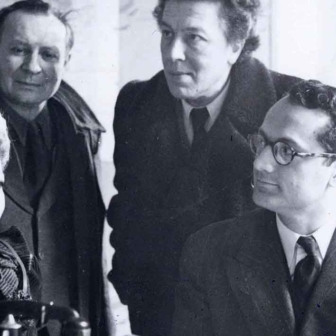Moving Data: The iPhone and the Future of Media
Edited by Pelle Snickars and Patrick Vonderau | Columbia University Press | $41.95
Studying Mobile Media: Cultural Technologies, Mobile Communication, and the iPhone
Edited by Larissa Hjorth, Jean Burgess and Ingrid Richardson | Routledge | $225
The Great Indian Phone Book: How Cheap Mobile Phones Change Business, Politics and Daily Life
Robin Jeffrey & Assa Doron | Hurst and Company | $45
THE first public mobile phone call was made just over forty years ago, on 3 April 1973. The caller was a Motorola engineer in New York City. The phone was a cream-coloured brick, a prototype of the Motorola DynaTAC 8000X, which weighed a kilogram and took ten hours to charge.
Over the past few weeks the international media has been throwing a birthday party for what is now a middle-aged technology (if you missed the festivities, try tiny.cc/40phone). The nostalgic photos of flip-phones and classic Nokias remind us how far the technology has come.
As it enters its fifth decade, the mobile is the centrepiece of a US$800 billion industry. Ubiquitous in virtually every nation, it has displaced the personal computer as the focus of investment and innovation in consumer technologies.
In recent years a growing body of research has been documenting the cultural history of mobile technology, exploring the diverse ways in which it shapes public and private life. Three recent books on the topic capture a representative sample of the fascinating debates under way.
WHILE early studies of mobiles focused on communications practices, researchers are increasingly interested in the mobile’s new status as a digital content platform. Moving Data explores this theme through a collection of short, scholarly essays. It approaches Apple’s iPhone from the perspective of media theory, seeing it as a paradigmatic object that crystallises a larger shift in the way culture is produced and distributed.
As the book’s editors argue, the iPhone brings with it a “convergence of technologies, cultures, and marketing practices that were previously thought incommensurable.” The contributors to Moving Data investigate, from different angles, this common theme — the coming together of tech companies, with experience producing hardware or online search, and the classic content industries of cinema and broadcasting, under the sign of the mobile.
This is a striking feature of today’s media landscape, but we are still grappling with its implications. Moving Data is very useful in this respect, offering absorbing case studies and critical analyses that help to put the changes in context. I particularly enjoyed Pelle Snickars’s chapter, which explores the debate about Apple’s App Store, the “walled garden” that provokes passionate criticism yet has fostered innovation; Göran Bolin’s philosophical ruminations on the history of mobile media technologies; and the chapters on regulation and corporate strategy by Jennifer Holt, Alisa Perren and Karen Petruska.
The book has a European skew, reflecting the backgrounds of many of its contributors, which makes for a welcome addition to the literature on the iPhone, a publishing genre dominated by American tech journalists.
Like Moving Data, Studying Mobile Media is concerned with convergence as a logic of today’s mobile industries. Despite what the title suggests, this is not a textbook but a collection of essays on different aspects of mobile industries and culture. The publisher’s hardback pricing might make this book one for libraries only (though many of the chapters can be found in draft online).
Together, the essays cover a representative spread of current debates, and are complemented by three case studies that focus on South Korea, China and Finland — nations with contrasting traditions of mobile take-up and use.
The book opens with a series of conceptual chapters, including a marvellous analysis by Brisbane-based media scholar Jean Burgess that frames “the iPhone moment” in relation to debates about innovation, creativity and gender. It then moves into some new and exciting areas, such as mobile gaming, mapping and photography. The mobile’s impact on each of these areas is hard to overstate.
Take photography: as the chapter by Daniel Palmer notes, the phone manufacturer Nokia has likely put “more cameras into people’s hands than in the whole previous history of photography.” Yet this boom in image-making has coincided with new social anxieties. Palmer’s essay explores the increasingly complex moral terrain of mobile photography in public places, like beaches and malls, where concerns about “upskirting” and other mobile-enabled nastiness make it difficult for professional photographers to shoot in the way they used to. But he also notes that today’s situation recalls an earlier age of photographic democratisation, at the end of the nineteenth century, when newly portable cameras created similar panics about “hand-camera fiends.”
Labour is another area of concern of this book. The question of who makes our devices, who does the coding for the apps, and who creates the value-added content necessary for social platforms is emerging as a renewed focus of debate. This theme appears throughout the essays, especially in chapters by Jack Linchuan Qiu — who examines the scandal around Foxconn, an Apple supplier whose Guangdong factory has been the site of strikes and suicides — and John Banks, who considers the shifting modes of production that underlie the development of mobile games.
THIS brings us to our third book, The Great Indian Phone Book, which has a more specific story to tell. India — a nation of 1.2 billion people and fifteen official languages, where the growth of telecom industries has been explosive — makes for a unique vantage point. In 1998, there were fewer than a million mobiles in India. Fourteen years later, the number of mobiles had leapt to almost 900 million. This is all the more remarkable given that most people had little engagement with fixed-line telephony, a technology reserved for elites and public servants.
In The Great Indian Phone Book, Robin Jeffrey (a political scientist) and Assa Doron (an anthropologist) have produced a riveting study that traces the effects of mobile technology on the lives of everyday people, from the fishermen who can now more effectively set the price of their catch to the electronic technicians who make a living from repairing banged-up handsets.
India’s mobile revolution has been premised not on high-end smartphones, which are the focus of the other two books, but on cheap, durable handsets. Many phones have multiple-SIM capabilities, allowing budget-conscious users to switch between carriers to take advantage of special rates. Nokia, not Apple or Samsung, is the market leader. There is a lively trade in secondhand handsets, and informal repair businesses can be found in the smallest villages.
II enjoyed how The Great Indian Phone Book approaches mobile culture from many different angles, including telecommunications policy (the skulduggery of spectrum auctions), cultural-economic history (the ad campaigns that market the mobile lifestyle), and infrastructure (the art of mobile tower construction). This is a 360- degree vision of mobile culture, grounded in everyday life but with a historical consciousness and a deep understanding of India’s cultural politics.
The book’s most absorbing parts are the ethnographic portraits that introduce us to a cross-section of Indian society, all touched in some way by the mobile. Readers will encounter peasants, parents, professionals, entrepreneurs, lovers, criminals and everyone in between.
With The Great Indian Phone Book, Jeffrey and Doron offer a timely reminder that mobile cultures are moving in many directions simultaneously. With convergence, the technological gap between the mobile and other devices is closing — but the uses to which the mobile is put around the world remain impossibly diverse. •




